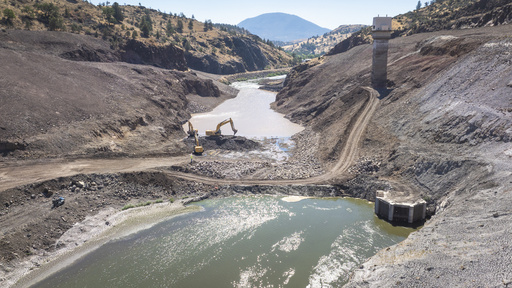Workers have initiated the process of breaching the final dams on a crucial section of the Klamath River, marking a significant step towards allowing salmon to freely swim through a major watershed close to the California-Oregon border after more than 100 years. This move is part of the most extensive dam removal project in the United States, nearing its completion.
Excavators were used by crews to dismantle rock dams that have obstructed water upstream of two dams – Iron Gate and Copco No. 1, both of which were almost entirely eliminated. By clearing these barriers, the river is now able to flow unobstructed in its original course, providing salmon with a pathway to essential habitats just in time for the fall Chinook spawning season.
Frankie Myers, the vice chairman of the Yurok Tribe, expressed in a statement, “Our sacred duty to our children, our ancestors, and for ourselves, is to take care of the river, and today’s events represent a fulfillment of that obligation.” The Yurok Tribe has long advocated for the removal of the dams to restore the river.
The removal of the four towering dams on the Klamath River is scheduled to be finalized within a month as part of a nationwide effort to allow rivers to return to their natural state, fostering the restoration of ecosystems for fish and wildlife. Various dams across the U.S., such as those on the Elwha River in Washington and the White Salmon River in Oregon, have been removed in recent decades to support river health.
The Klamath River, previously renowned as the third-largest salmon-producing river on the West Coast, saw a decline in its fish population due to the construction of dams by PacifiCorp between 1918 and 1962. The dams disrupted the river’s natural flow, impacting the salmon lifecycle. After decades of advocacy, a plan was approved in 2022 to remove the dams, with noticeable progress already witnessed.
While the dam removals will have a minimal impact on power supply, producing less than 2% of PacifiCorp’s energy, efforts are focused on restoring the river ecosystem and bringing back the salmon population, essential for the tribes in the region. The project, costing approximately $500 million, is funded by taxpayers and PacifiCorps ratepayers.
Although the return of salmon to their historical habitats and the river’s recovery timeline remains uncertain, there have been initial reports of salmon at the river’s mouth, beginning their journey upstream. Expectations are high for the successful migration of fish past the Iron Gate dam, aiming for early accomplishments in salmon restoration efforts.
It is acknowledged that restoring the river system and fish habitats will take time, considering the extensive impact of a century of dam operation. There are plans in place to monitor the progress of salmon reintroduction and observe the healing of the river as it returns to its natural state.




